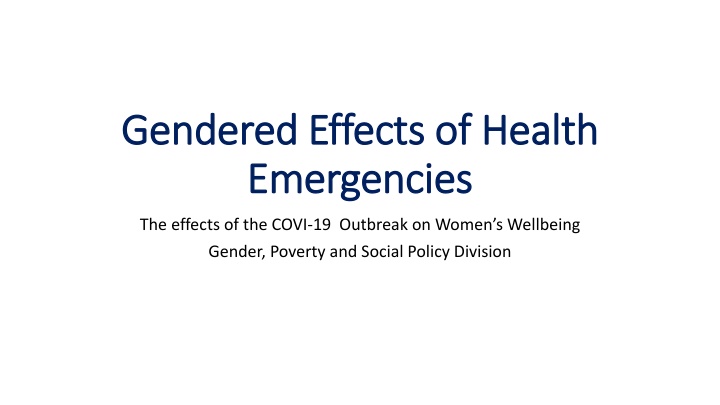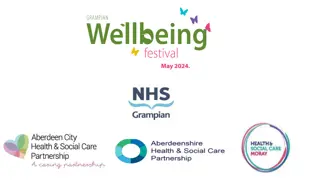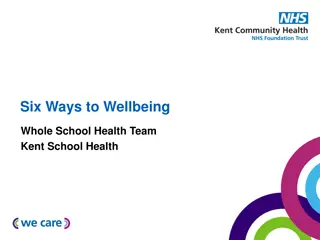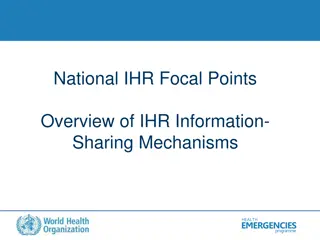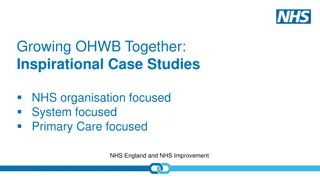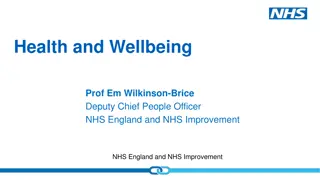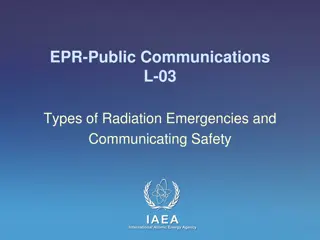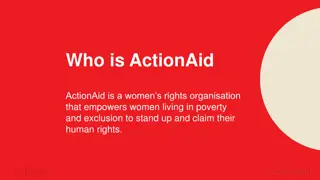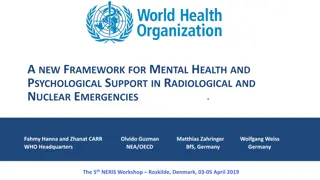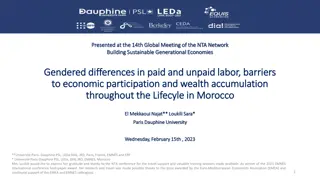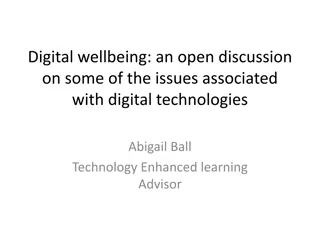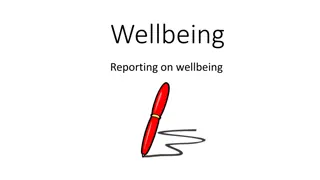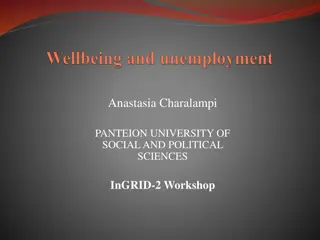Gendered Effects of Health Emergencies: Impact on Women's Wellbeing
Gender inequalities contribute to unequal health and wealth outcomes, with disparities in access to education, healthcare facilities, and employment impacting women's wellbeing. During health emergencies like the COVID-19 outbreak, resources are diverted from sexual and reproductive health services, disproportionately affecting women. Female health workers, who make up a significant portion of caregivers, face higher risks of infection. Addressing these gendered effects is crucial for promoting overall wellbeing and reducing poverty and health disparities.
Download Presentation

Please find below an Image/Link to download the presentation.
The content on the website is provided AS IS for your information and personal use only. It may not be sold, licensed, or shared on other websites without obtaining consent from the author.If you encounter any issues during the download, it is possible that the publisher has removed the file from their server.
You are allowed to download the files provided on this website for personal or commercial use, subject to the condition that they are used lawfully. All files are the property of their respective owners.
The content on the website is provided AS IS for your information and personal use only. It may not be sold, licensed, or shared on other websites without obtaining consent from the author.
E N D
Presentation Transcript
Gendered Effects of Health Gendered Effects of Health Emergencies Emergencies The effects of the COVI-19 Outbreak on Women s Wellbeing Gender, Poverty and Social Policy Division
Gender inequalities lead to unequal Gender inequalities lead to unequal health and wealth outcomes health and wealth outcomes Inequalities across health and education matter for impact on gendered effects on well being outcomes as there are 1. Distortions in returns of education; 2. Negaitve externalities of inadequate and unequal educational attainment; 3 Demographic Effects that impact more on women; 4. Health behavioural effects and access to facilities (On average, less than 1 in 5 of the poorest quintile of African have access to clean water and about 570 million urban slum dwellers. Gaps in Formal Employment (and type of employemnt) matter for Poverty and Health Outcomes: 1. Distortion in types of employment (The working poor about 60-65 million can t afford to self quarantine) ; 2. Makes labor-intensive growth strategy more difficult; 3. Employment rights and bargaining power impact disproprtionately on women ; 4, Employment, governance and rights Inequality and gaps in gender, matter for production and household time poverty. If there are 1. Distortions due to unequal access to assets and inputs; 2. distortions regarding adoption of new technologies; 3. Inefficiencies due to high and unequal time burdens in household economy . All will contrubte to postulating increased probability on intrahousehold poverty transmission (Time, Welfare and Multidimensional Poverty)
Diversion of health spending away from S&RH Diversion of health spending away from S&RH During outbreaks, health resources are diverted towards outbreak prevention and response, and away from other areas including sexual and reproductive services. Quarantine policies further reduce access to sexual and reproductive services. Across the Ebola-infected region, the number of women giving birth in hospitals and health clinics dropped by 30% during the outbreak and the maternal mortality rate increased 75%.** HIV/AIDS, over the last four decades, has clearly shown the burden of care falls disproportionately on women, to ensure intergenerational well being of households **Davies, Sara and Belinda Bennett (2016) A gendered human rights analysis of Ebola and Zika: locating gender in global health emergencies , International Affairs 92(5): 1041 60 reported in Smith, J. Overcoming the tyranny of the urgent : integrating gender into disease outbreak preparedness and response, Gender & Development, Vol. 27, Issue 2. S*RH = Sexual and Reproductive Health
Paid care work in health centres 1 Paid care work in health centres 1 The vast majority of nurses are females in Africa: 65% of all nurses are females, while 72% of all doctors are males.* Evidence from the Ebola crisis in West Africa from 2014 to 2016 shows that health workers were more likely than other groups to become infected and die after being infected (Table 1). Since they will be more involved in the care of those infected by COVI- 19, it is expected that female health workers are more likely to be infected with the virus. *Boniol M, McIsaac M, Xu L , Wuliji T, Diallo K and Campbell J. 2019. Gender equity in the health workforce: analysis of 104 countries: WHO Working Paper 1
Paid care work in health centres 2 Paid care work in health centres 2 Table 1. Ebola Outbreak: Cases and deaths in Guinea, Liberia and Sierra Leone, 2014- 2016 All cases Health workers Cumulative cases Cumulative deaths Percentage deaths (%) Cumulative cases Cumulative deaths Percentage deaths (%) Guinea 3,800 2,534 66.7 196 100 51.0 Liberia 10,666 4,806 45.1 378 192 50.8 Sierra Leone 13,982 3,955 28.3 307 221 72.0 Total 28,448 11,295 39.7 881 513 58.2 Source: http://apps.who.int/ebola/current-situation/ebola-situation-report-14-october-2015
Time spent on different types of work in Africa by age and gender Time spent on different types of work in Africa by age and gender
Unpaid care work at home 1 Unpaid care work at home 1 Chart 1 (and Previous Chart) Time spent by women compared to men in unpaid work (number of times) Women shoulder the majority of unpaid activities in the home including looking after the sick and young children, and to fetch water. Ethiopia 2013 2.3 South Africa 2010 2.3 South Africa 2000 2.6 Tanzania 2006 2.9 Benin 1998 3.2 Ghana 2009 3.2 Tanzania 2014 3.7 Mauritius 2003 3.8 Madagascar 2001 4.4 Algeria 2012 5.3 Tunisia 2005-06 6.0 Morocco 2011-12 7.0 Mali 2008 11.4 Source: Charmes, J. (2015). Time use across the World: Findings of a World Compilation of Time Use Surveys. Background paper prepared for the UNDP s 2015 Human Development Report. Available at: http://www.hdr.undp.org/sites/default/files/charmes_hdr_2015_final.pdf Year of survey follows country name.
Lesotho Case Study: Covi Lesotho Case Study: Covi- -19 and gendered time poverty* 19 and gendered time poverty* Infrastructure is vital in tackling the effects of health shocks and Covi-19 In Lesotho the distance men and women have to travel to reach the nearest drinking water, health centre, primary school or public transport is correlated with time poverty Women headed households, in particular, combine domestic and formal work with caring for children and HIV/AIDS sufferers. Currently : I/3rd of women travel for more than 1 hour to collect water. Besotho women spend, on average, 1.5 hours per day caring for a family member 40% women take at least 1 hour to get to the nearest health centre. Covi-19 impact may accentuate the gendered dimensions of infrastructure usage: Average caring time by women may increase by 30% to 2 hours + However, assuming a higher corona mortality rate for those aged 60 +, the increased caring time will fall disproportionately on the 35-45 year olds 40% women take at least 1 hour to get to the nearest health centre. * Source: Lawson, D. (2008), Infrastructure and Time Poverty in Lesotho , South African Journal of Economics, Vol 76 (1): 77-88.
Covi Covi- -19 and home unpaid care work 19 and home unpaid care work Lack of investment in health systems sick relatives have to be taken care home (with care time accentuated already unfavourable gendered effects on women COVID-19 will accentuate this (Males (64+ years) Effects ,ade worse when existing health facilities are closed to slow down the spread of the outbreak. Schools/pre-schools closed to prevent spread of disease women have to take time of work to take care of young children. Avoiding Covi-19 Gendered Time Effects Increased demand for clean water for more frequent washing of hands More time spent to fetch water Ill health effects Gendered fiscal space and budgeting considerations for infrastructure support required Localized mobile testing units in villages are required Increased localized (temporary) water (tankers) and health stations THESE FACTORS WILL HELP WOMEN DECREASE Risk of infection DECREASE Time poverty INCREASE Well being
Engendering social protection responses Engendering social protection responses Social Protection What Action is Required Now? African countries should consider the merits of decentralizing their health services to enhance health response capacity locally.Learn from Ebola Crisis in terms of social distancing and overall cost Move to advance payments for pension and cash transfers programs for example in national pensions schemes across Lesotho, Namibia and Malawi s etc Elderly have an overall 30 percent coverage in Africa s social protection programmes, extend coverage (Lower age criteria) and ensure health access Top up income support in poor householdsdepending on situation for example deaths, loss of livelihood, etc. Maintain regular feeding and health programs including school feeding based on local production Linkages and referral system for this emergency must be set up for all nationals Elderly in Urban Areas should be prioritised Support social programs for elders and vulnerable using technology based system for virtual bank transfers Strengthen social support system
General recommendations General recommendations Flatten the infection curve through social distancing measures and appropriate health practices: o To buy more time for the health system to cope better with pandemic. o Resulting in more people treated within health facilities reduce care burden on households. Maintain health care services including sexual and reproductive health services. Protecting health workers: by prioritizing their access to disposable filtering face-piece respirators, given that these are in limited supply. Support social distancing measures through temporary social assistance to ensure that workers can remain employed even if quarantined or forced to stay home to look after dependents. Increase supply of hygiene activities accessible clean water, sanitizers,, etc.
Conclusion : Gender Conclusion : Gender- -aware planning and decision aware planning and decision- - making making Gender-aware analysis: Increased use of sex-disaggregated data to analyse the differential effects of CORVID-19 on men and women. Gender-aware policy-making: Plan for future public health emergencies to take account of differential needs of men and women - Fiscal Space and Gender Budget Planning Participation in decision-making: Greater participation of women in decision-making positions in public health and emergency response to ensure that the needs of women and girls are adequately taken into account.
